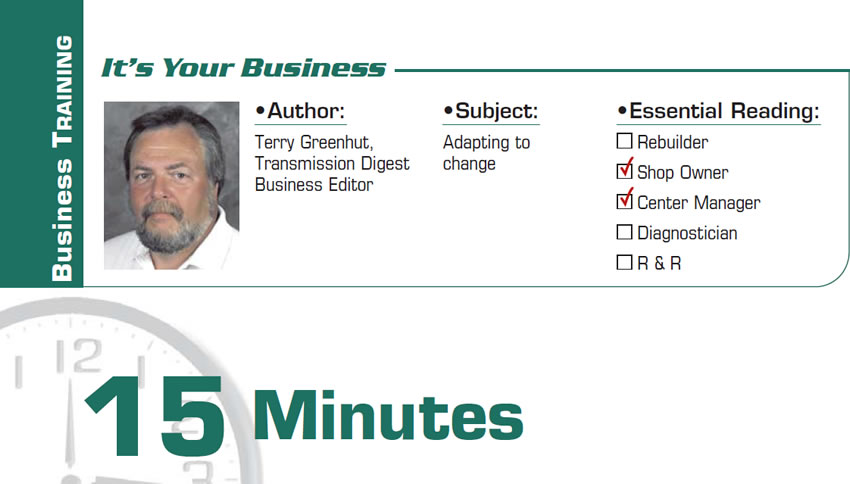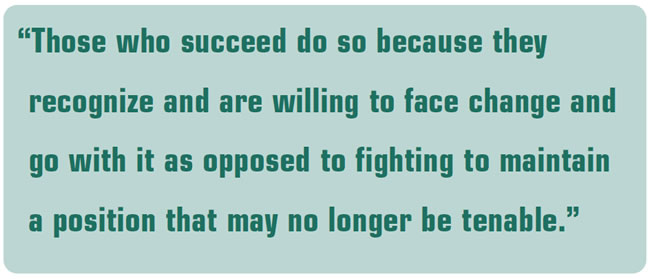
It’s Your Business
- Subject: Adapting to change
- Essential Reading: Shop Owner, Center Manager
- Author: Terry Greenhut, Transmission Digest Business Editor
In golf we say, “Everything’s good for 15 minutes.” Whenever someone teaches us a different way to swing or grip a club, whenever we buy a new piece of equipment or whenever we change anything, it works for about 15 minutes. After that it doesn’t anymore and we have to find something else.
Now, “15 minutes” is just an expression. Many changes last considerably longer, but the idea is that nothing is forever and most changes reap only short-term benefits. We have to keep tweaking and reinventing our golf game to maintain or improve our scores.
Business is the same way. We try new promotions, new or different forms of advertising; we hire and train new people; we reinvent systems, and whenever we think we have it just right everything changes and we have to do it all again.

That’s what business is all about – change. Those who succeed do so because they recognize and are willing to face change and go with it as opposed to fighting to maintain a position that may no longer be tenable.
When we had to learn electronics back in the ’80s many shop owners chose to retire or sell out rather than learn something they might have thought was beyond their comprehension. Many who stayed and learned how to fix the new systems didn’t necessarily learn how to sell those fixes correctly, resulting in their thinking that the new technology wasn’t going to allow them to make money. Those who really wanted to make a go of it bought and continue to buy all the latest tools and diagnostic equipment, and they learn how to use it and how to charge for it. They realize that high tech requires high drama as well; in other words, show business. They use it during the initial conversation and throughout the entire sales process to make customers understand why they have to pay substantial amounts to have their cars repaired. They take the extra time to make sure customers understand what they are being asked to pay for and why.
In the transmission- and auto-repair business the one thing we can rely on not changing is that nobody wants to buy what we have to sell. They never did and they never will. That’s a constant, and although it doesn’t always make our job easier it’s good we have it. It reminds us that we can never be complacent during good times or bad, because for the customer who needs car repairs times are always bad. They don’t expect a major component to break, just as I didn’t expect to have to pay out $3,300 for a new air-conditioning compressor for my house last week, but I had to. I’m still not happy, but I am cool. If I hadn’t bought it I would be unhappy and hot, so I guess one out of two ain’t bad. You can give your customers one out of two as well. You can give them a quality repair and the peace of mind that goes with it if they are willing to give you a fair price.
We have another constant that’s good to always keep in mind. Every time we try to cut corners to satisfy a customer who doesn’t want to pay us what we need to do a good job and back it with a substantial warranty, we get bitten. It always winds up costing us much more than the discount we gave. Think about it: If we discount a price and then try to make up for it by not doing our best job we open ourselves up to the probability of having to do it over. That means we’ve lost money twice – once on the sale and again on the comeback – not to mention the damage to our reputation.
What still changes every five minutes is the financial condition of our customers, the way we must market to them, and the extra time and varied methods we sometimes need to employ to get them to buy everything we believe they need. What we can’t afford to let change is the profit structure we determine is necessary for us to make the money we need. Although the world is in tough financial times nobody seems to be lowering prices to us. The cost of everything we need to do business keeps on rising, so there’s no way that it makes sense for us to lower our prices despite our customers’ wanting us to.
What works and what doesn’t are the two major considerations for these volatile times, because we can’t keep dumping money into advertising and promotion that doesn’t bring a positive return. We also can’t keep paying employees or outside contractors who aren’t contributing to our profit stream.

More than ever we need to track the effectiveness of our advertising and the productivity of our shops. Every new customer needs to be asked very specifically how they came to us so that we can determine which advertising doesn’t work so we can cut it from the budget and what does work so we can increase our investment in it if necessary. For example, if a customer says he found you in the yellow pages and you have ads in several books, find out which book.
If you have a little time to talk with the customer find out what it was about your ad that attracted him and what made him choose your ad over all the others. It would be great if you could interview the people who did not call you and chose someone else’s ad over yours to find out why they did so, but you can’t. What you can do is ask friends or business associates to look at all the ads in your category and tell you what if anything attracts them to ads other than yours. Even better, ask total strangers to do it so they won’t be influenced by already knowing you.
Many of our customers come by way of referral. They are the easiest to sell, they question price the least and they can become some of our most loyal. Capitalize on them by finding out who referred them and why. What were they told about your shop? Were they told you were the best? Did they come to you because they’d had a bad experience somewhere else? Are they there because you offer a unique specialty? Did they come because you answered the phone properly and did a good job of talking them in compared with others they called?
When you get a referral be sure to reward or at least thank the referring party. They need to know you appreciate their efforts so they continue to refer people to you. Make it a point to call the referring party immediately after the job is completed. Keep the repair order out and somewhere that forces you to look directly at it until you make the call. Then you can file it away.
Here’s a different slant for you. Don’t send a coupon for a free oil change or dinner for two at a local restaurant as has become the custom of late. Those actions too closely resemble a payment of commission for sending a customer. Although you are happy to pay another business for a referral because you know they are looking for it, a retail referral is rarely done for money. It’s a friend helping a friend. If you want to acknowledge the action, call or send a thank you card and then wait till the referrer’s next visit to the shop. At that point again thank them and, if you want, throw in the free oil change or whatever bonus you want to give. That way it isn’t viewed as a scheme to get them back into your shop but as a true benefit of their loyalty.
Many shops have gotten out of the habit of attending trade shows and seminars. Although you may not need to attend everything every year, you do need to get out and meet with fellow owners and managers to see what they’re doing to promote business. With technology still changing rapidly and employees being replaced from time to time, the people you sent for training as few as a couple of years ago may no longer be with you so new ones need to be trained. Always keep in mind when thinking about a training or equipment expenditure that technicians and service advisers can’t make you money till they know what they’re doing and have the right tools and equipment to work efficiently.
Yes, a lot changes, but some basic concepts endure; a good honest job at a profitable price will always prevail. Change the way you promote, maybe the way you hire and fire, but never change the mission of your business: to provide excellence at a fair price.

Terry Greenhut, Transmission Digest Business Editor. Visit www.TerryGreenhut.com.













